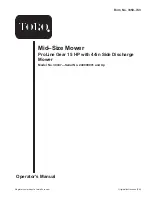
23
GB
www.scheppach.com
+(49)-08223-4002-99
+(49)-08223-4002-58
• Disconnect the plug from the power source
and/or the battery pack from the power tool-
before making any adjust -ments, chang-
ing accessories, or storing power tools.
Such preventive safety measures reduce the risk
of starting the power tool accidentaIly.
• Store idle power tools out of the reach of chil-
dren and do not allow persons unfamiliar with
the power tool or these instructions to operate
the power tool
. Power tools are dangerous in the
hands of untrained users.
• Maintain power tools. Check for misalignment
or binding of moving parts, breakage of parts
and any other condition that may affect the
power tool’s operation.
If damaged, have the
power tool repaired before use.
Many accidents
are caused by poorly maintained power tools.
• Keep cutting tools sharp and clean
. Properly
maintained cutting tools with sharp cutting edges
are less Iikely to bind and are easier to control.
• Use the power tool, accessories and tool bits
etc. in accordance with these instructions, tak-
ing into account the working conditions and
the work to be performed
. Use of the power tool
for operations different from those intended could
result in a hazardous situation.
Careful handling and use of battery devices
• Charge the batteries only in chargers that are
recommended by the manufacturer.
Risk of fire
if a charger that is suitable for a specific type of
battery is used with other batteries
• In the power tools, use only the batteries de-
signed for the purpose.
The use of other batteries
may result in injuries and risk of fire
• Keep the unused battery away from paper clips,
coins, keys, nails, screws and other small metal
objects, which could cause bridging of the con-
tacts.
A short circuit between the battery contacts
may cause burns or fire
• If used incorrectly, liquid may leak from the
battery. Avoid contact with this. In the event of
accidental contact, rinse off with water. If the
liquid gets into eyes, seek medical assistance.
Leaking battery fluid may cause skin irritations or
burns.
• Observe the operating manual and the safety
instructions enclosed with the rechargeable
battery or charging unit.
Service
•
Have your power tool serviced by a qualified
repair person using only identical replacement
parts.
This will ensure that the safety of the power
tool is maintained
• Keep electric tools away from rain and mois-
ture.
Water entering an electric tool increases the
risk of an electric shock.
• Do not use the cable for another purpose, for
example, carrying or hanging the electric tool
or pulling the plug out of the socket. Keep the
cable away from heat, oil, sharp edges or mov-
ing device parts.
Damaged or coiled cables in-
crease the risk of an electric shock.
• If you work with an electric tool outdoors, on-
ly use extension cables that are also suitable
for outdoor use.
Using an extension cable suit
-
able for outdoor use reduces the risk of an elec
-
tric shock.
• If you cannot avoid using the electrical tool in
a wet environment, use a fault-current circuit
breaker.
Using a fault-current circuit breaker re
-
duces the risk of an electric shock.
Personal safety
• Stay alert, watch what you are doing and use
common sense when operating a power tool.
Do not use a power tool while you are tired or
under the influence of drugs, alcohol or medi
-
cation.
A moment of inattention white operating
power tools may result in serious personal injury.
• Use personal protective equipment. Always
wear eye protection.
Protective equipment such
as dust mask, non-skid safety shoes, hard hat, or
hearing protection used for appropriate conditions
will reduce personal injuries.
• Prevent unintentional starting. Ensure the
switch is in the off-position before connecting
to power source and/or battery pack, picking
up or carrying the tool.
Carrying power tools with
your finger on the switch or energising power tools
that have the switch on invites accidents.
• Remove any adjusting key or wrench before
turning the power tool on.
A wrench or a key left
attached to a rotating part of the power tool may
result in personal injury.
• Do not overreach. Keep proper footing and bal-
ance at all times.
This enables better control of
the power tool in unexpected situations.
• Dress properly. Do not wear loose clothing or
jewellery. Keep your hair, clothing and gloves
away from moving parts.
Loose clothes, jewellery
or long hair can be caught in moving parts.
• If a grass box can be attached, ensure that it
is installed and used properly.
Power tool use and care
• Do not force the power tool. Use the correct
power tool for your application
. The correct
power tool will do the job better and safer at the
rate for which it was designed.
• Do not use the power tool if the switch does not
turn it on and off
. Any power tool that cannot be
controlled with the switch is dangerous and must
be repaired.
















































